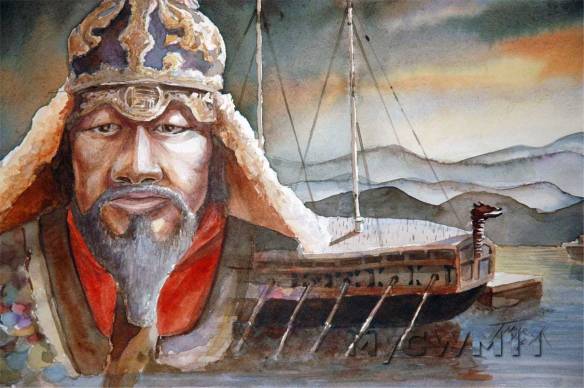Born: April 28, 1545
Died: December 16, 1598
Korean Admiral
Yi Sun-sin was originally an Army Commander who earned his reputation fighting Manchu nomads on Korea’s northern border. After a period out of power, he was made Commander of the Cholla Naval District. Faced with the looming threat of a Japanese invasion, Yi took vigorous measures to prepare his fleet for war. He began collecting supplies and improving the equipment on his ships. Alongside the cannon armed warships – known as panokseon, which formed the core of his fleet – he built a number of geobukseon (turtle ships), whose upper decks were enclosed in iron plates. Yi’s task as an Admiral was to maneuver these gun platforms so that his cannons – firing solid shot and incendiary rounds – destroyed the lighter Japanese warships, while avoiding being boarded by the well-armed Japanese soldiers. Yi achieved this by exploiting his superior knowledge of the sea currents and channels around the Korean coastline.
Yi is credited with 23 victories against Japan. His greatest triumph during the first invasion was the engagement at Hansando, in August 1592, where the Japanese ships had been lured into an encirclement from which only a handful escaped. Success earned him jealousy at the Korean courts, however. Yi was arrested, tortured, and relegated to common soldier. A severe naval defeat during the Second Japanese Invasion quickly brought Yi’s reinstatement as Admiral.
There are many factors to consider in why Admiral Yi was so successful against the Japanese. Admiral Yi took a vested interest in his men and ensured that his soldiers, supplies, and his ships were well-maintained. He expended all efforts to replace them when necessary. The turtle ship also played a significant role in his victories. He expertly navigated them against the Japanese because he had knowledge of the Korean coast and knew the sea tides and used the terrain and weather to his advantage. Like most great leaders, he was charismatic and excelled at motivating his soldiers and sailors. He treated them with respect and dignity and in return earned their loyalty.
His turtle ships had stronger hulls than the Japanese ships of that period. They were also capable of carrying at least 20 cannons which were useful in broadsiding. He personally led development of additional types of cannons that proved useful in battle. In 1597 Admiral Yi led his ships into battle at Myeongnyang against the Japanese fleet of Toyotomi Hideyoshi. Admiral Yi brought with him at least 12 panokseon warships, and they faced off against the considerable naval force of the Japanese, which numbered 133 warships and at least 200 logistical ships.
The Japanese Navy had arrived in the Yellow Sea and sent out an advance scouting party. They soon staged a surprise attack, but were driven off. A second scouting party later launched another nighttime attack, but Yi repelled them again.
All ships were ordered to return to the Japanese Fleet when they received reports that there was Korean resistance in the area. They began to amass their fleet. Admiral Yi did not want to fight a major sea battle in such a vulnerable position, so he withdrew his forces and concealed his ships on the northern side of the strait. Positioning his ships in the strait gave him a tactical advantage. The narrow strait prevented his small group of ships from being flanked by the massive Japanese Fleet. The roughness of the currents also made it exceedingly difficult for the Japanese ships to maneuver and close in. This forced the Japanese to attack in smaller groups.
Early on the morning of October 26th, the Japanese fleet began to deploy around the bay at the end of the strait. The crews of Yi’s other ships were survivors of a recent naval battle under the command of a different Admiral, and were shaken by the numerically superior Japanese fleet. It is recorded that for a time only Admiral Yi’s flagship was engaged in combat. He advanced alone but soon his example of bravery drew out the other ships one by one. His warships fired both cannon and arrows and were careful to avoid Japanese boarding attempts, as this was their primary tactic of the period. Several Japanese vessels attempted to come alongside the Korean ships but were driven off or sunk with concentrated fire. The tide in the strait soon reversed. The panokseon dropped their anchors while the Japanese ships were pushed back by the tide and soon began to smash upon one another. The Japanese ships clustered and crashed, forming a target rich environment for the Korean ships. The strong tides prevented Japanese sailors from swimming safely to shore and many drowned while attempting to escape their sinking vessels. By the end of the battle, records show that nearly thirty Japanese vessels were damaged or destroyed. The defeat was crushing to the morale of the Japanese and caused difficulties in resupplying their ground forces. The victory had the opposite effect for the Korean ground forces who had previously been fighting a losing front. When word spread of Admiral Yi’s victory, spirits ran high.
While this battle demonstrates the strategic prowess of Admiral Yi, this victory alone failed to slow or stop the Japanese campaign in Korea.
During the final struggle of the war at Noryang in November 1598, Yi was shot by a Japanese arquebus and died on the deck of his ship. Admiral Yi Sun-sin is considered a national hero and is celebrated by statues in a number of Korean cities, including Seoul.
